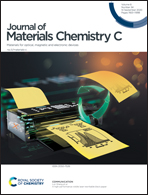White emissive europium complex with CRI 95%: butterfly vs. triangle structure†
Abstract
The spectral window of dual visible light emissions of the molecular europium complex that leads to white light can be modulated by design strategy. A europium complex with butterfly structure displays dual emission that leads to single phase white light-emitting molecular complex with excellent colour quality. Such behaviour is not observed with an analogous europium complex with a triangular structure (rather shows usual red emission), suggesting that the partial lighting up of europium ion along with the ligand (antenna) emission (controlled energy transfer from ligand to the Eu(III) ion) is more imperative for the creation of white light. The white light emitting diode (LED) assembled using butterfly europium phosphor as a white emitter yields a bright pure white light with CRI (95%), CCT (5457 K), and CIE (x = 0.33, y = 0.33), whereas the triangle Eu-phosphor displays red light with CIE value of x = 0.58, y = 0.31. The fabricated white/red LED continued to emit a bright white/red light for more than a year. The present design strategy can be widely adapted for the synthesis of single-phase white emitting Eu-phosphor. In addition, the presently studied complexes have also been explored for temperature sensing and as a sensor for vapoluminescence.

- This article is part of the themed collection: Journal of Materials Chemistry C HOT Papers


 Please wait while we load your content...
Please wait while we load your content...